Capture the vivid hues of Florida’s avian life with our guide to 15 Orange Birds in Florida! From migrants that add a seasonal splash of color, to year-round residents that consistently grace our landscapes, each bird offers a unique spectacle.
Timing is everything in bird-watching, so remember, the best times to see these vibrant creatures may vary throughout the year. For the most accurate and up-to-date information, always check local and seasonal bird guides. Now, let’s embark on this colorful journey, complete with a free photo guide for your reference and enjoyment.
Orange Birds Found In Florida
Florida’s unique geography, comprising a wide range of ecosystems from coastal beaches and marshlands to forests and grasslands, coupled with its mild climate, provides an ideal habitat for a diverse array of bird species, including a captivating variety of orange birds.
Baltimore Oriole


| Feature | Measurement |
|---|---|
| Scientific Name | Icterus galbula |
| Length | 6.7–8.7 in |
| Wingspan | 9.1–12.6 in |
| Weight | 22.3-42 g |
The Baltimore Oriole is a stunning bird, best known for its vibrant coloration and its rich, whistling song.
Appearance: The male Baltimore Oriole is notable for his bright orange and black plumage and black and white wing bars, a stark contrast to the more muted yellow-brown coloration of the female. Both sexes, however, have long pointed bills and white bars on their wings.
Diet: Baltimore Orioles have a diverse diet that includes insects, fruits, and nectar. Their preference for sweet juices and fruit pulp often brings them to backyard feeders offering oranges and jelly.
Reproduction: The female Baltimore Oriole is responsible for building the distinctive hanging nest, often woven together from fine materials like hair and grass. These nests are usually high in trees to avoid predators. The female lays 3-7 eggs, which are incubated for about two weeks.
Orchard Oriole
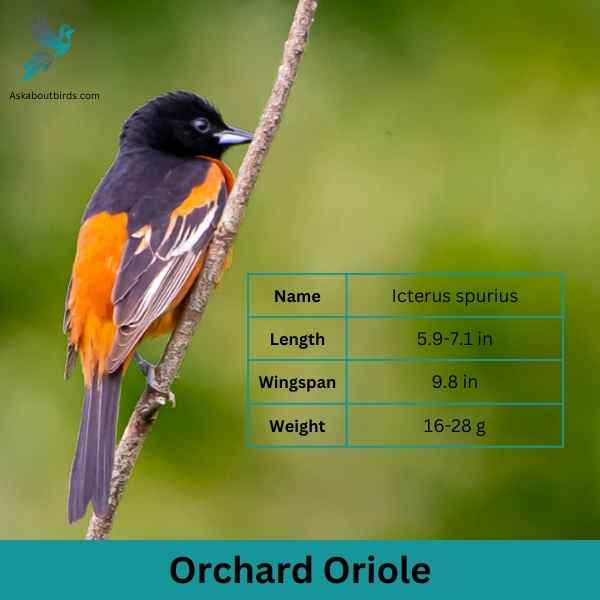
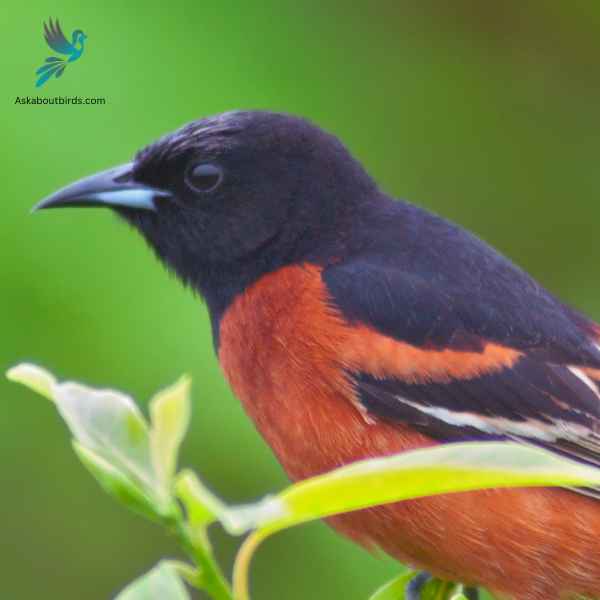
| Feature | Measurement |
|---|---|
| Scientific Name | Icterus spurius |
| Length | 5.9-7.1 in |
| Wingspan | 9.8 in |
| Weight | 16-28 g |
The Orchard Oriole is a small songbird noted for its distinctive coloration and melodic song.
Appearance: Male Orchard Orioles are a striking sight with their dark chestnut body and black head and black and white wings, while females and immature males are olive-green and feature a yellowish underpart. The species is often recognized by its slender body and pointed bill.
Diet: The diet of the Orchard Oriole consists primarily of insects, fruits, and nectar. They are adept at catching insects mid-air and are also known to sip nectar from flowers, aiding in pollination. When fruits are in season, they make up a substantial portion of the bird’s diet.
Reproduction: Orchard Orioles often nest in open woodlands and orchards, hence their name. The female is responsible for building the nest, typically choosing a location in a tree or shrub. The female lays a clutch of 4 to 6 eggs, which she incubates for about two weeks.
American Robins


| Feature | Measurement |
|---|---|
| Scientific Name | Leptotila plumbeicep |
| Length | 10.6-11.8 in |
| Wingspan | — |
| Weight | 160-200 g |
The American Robin is a widely recognized bird species known for its melodious song and early bird tendencies.
Appearance: American Robins are medium-sized birds with a distinctive appearance. Both males and females sport a gray to brown back and a warm red to orange breast and belly and gray wings. They also have a characteristic white eye-ring and a black head, but males are usually darker than females.
Diet: American Robins have a diverse diet that changes depending on the season. In summer, they feed heavily on earthworms, beetles, and other invertebrates, which they catch on the ground. During winter, they mostly eat fruits and berries.
Reproduction: American Robins usually build their nests in trees or shrubs, but they are also known to nest on human-made structures. The female lays a clutch of about 3 to 5 eggs, which she incubates for about 12 to 14 days.
Barn Swallow

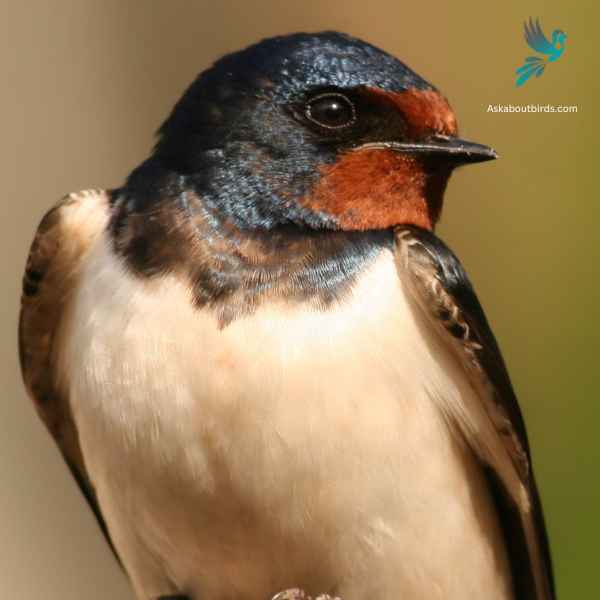
| Feature | Measurement |
|---|---|
| Scientific Name | Hirundo rustica |
| Length | 6.5–7.5 in |
| Wingspan | 12.5–13.5 in |
| Weight | 16–22 g |
The Barn Swallow is a sleek, agile bird renowned for its graceful flight patterns and iconic forked tail, often seen darting over fields and water bodies in search of flying insects.
Appearance: Barn Swallows have deep blue, almost iridescent, upperparts and a rufous to tawny underbelly. Their distinctively forked tail and long wings give them a streamlined look. Both males and females have a similar appearance, though males often exhibit slightly brighter colors and a deeper fork in the tail.
Diet: Barn Swallows feed primarily on flying insects, which they catch in mid-air during their agile and acrobatic flights. Their diet includes flies, beetles, moths, and other small flying insects.
Reproduction: Barn Swallows are known for building their mud nests on man-made structures, particularly barns, bridges, and eaves. The nest is cup-shaped and made from mud pellets, often lined with feathers. The female lays a clutch of 4 to 6 eggs.
Red-breasted Nuthatch

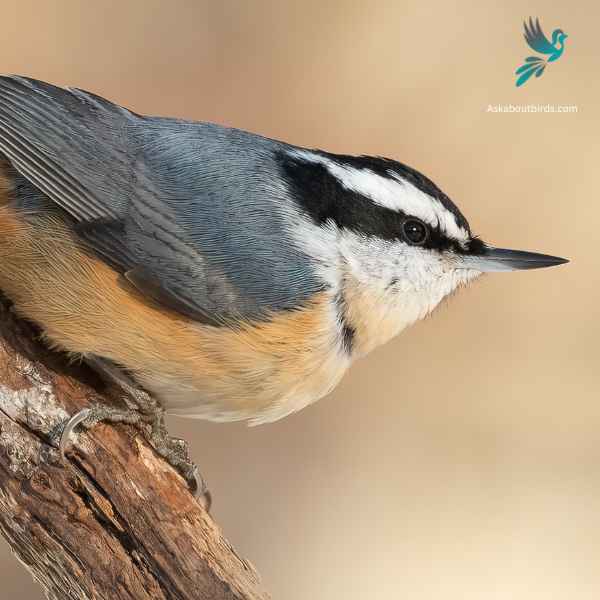
| Feature | Measurement |
|---|---|
| Scientific Name | Sitta canadensis |
| Length | 4.3–4.7 in |
| Wingspan | 8.3 in |
| Weight | 0.3–0.5 oz |
The Red-breasted Nuthatch is a small, agile songbird, known for its ability to move headfirst down tree trunks while searching for food.
Appearance: This bird boasts a slate-blue back and a pale rust-red underside. A prominent black stripe runs through the eye and is bordered above by a white eyebrow. Their sharp, pointed bill is characteristic of the species.
Diet: Red-breasted Nuthatches primarily feed on insects and seeds, especially those from coniferous trees. They have a fondness for large seeds, which they wedge into bark crevices to hack open with their bills.
Reproduction: These birds construct nests in natural tree cavities or abandoned woodpecker holes, often lining the entrance with resin. This is thought to deter predators or competitors from entering. The female typically lays a clutch of 5 to 6 eggs, and both parents partake in feeding the chicks once they hatch.
Eastern Towhee

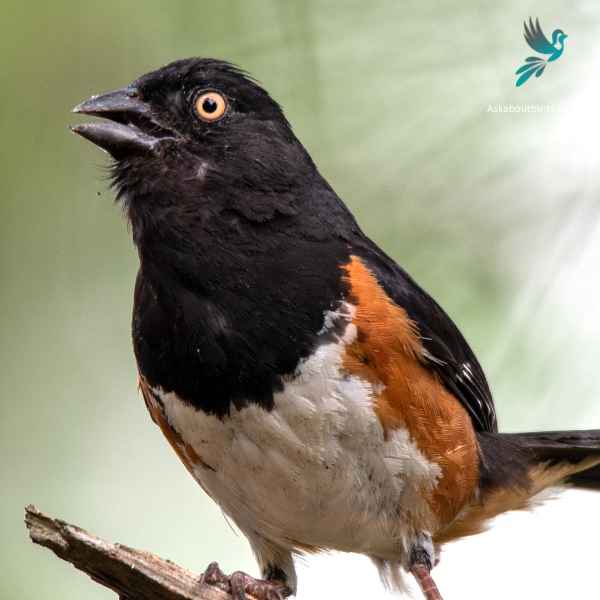
| Feature | Measurement |
|---|---|
| Scientific Name | Pipilo erythrophthalmus |
| Length | 6.8 to 9.1 in |
| Wingspan | 7.9–11.8 in |
| Weight | 32 to 53 g |
The Eastern Towhee is a distinctive songbird known for its unique calls and eye-catching coloration.
Appearance: Male Eastern Towhees are characterized by a striking combination of a black head, back and tail, contrasting with a white belly and rufous flanks. Females sport similar patterns but instead of black, they have a rich brown color. Both genders have red eyes, lending a special charm to their overall appearance.
Diet: Eastern Towhees primarily feed on a variety of insects, seeds, and berries. Their diet is quite diverse, taking advantage of seasonal offerings, which includes beetles, caterpillars, spiders, acorns, grass seeds, and various fruits and berries.
Reproduction: Eastern Towhees build their nests on or near the ground, often in a shrub or a small tree. The female lays around 3-5 eggs and takes the primary role in incubating them over about 12-13 days.
American Redstart


| Feature | Measurement |
|---|---|
| Scientific Name | Setophaga ruticilla |
| Length | 4.3 to 5.5 in |
| Wingspan | 6.3 to 9.1 in |
| Weight | 8.6 g |
The American Redstart is a lively warbler known for its vivid colors and active hunting style, often seen flitting about, fanning its tail to startle and catch insects.
Appearance: Adult male American Redstarts boast striking black plumage with bright orange patches on the sides, wings, and tail. Females and immature males have grayish-olive upperparts with yellow patches in the same areas where the males display orange.
Diet: American Redstarts are primarily insectivores. They actively forage for flying insects, as well as caterpillars and spiders, often using their colorful tails to startle prey and make them easier to catch.
Reproduction: The female American Redstart builds a cup-shaped nest in the fork of a tree branch. Typically, she lays a clutch of 3 to 5 eggs. The female takes on the primary responsibility of incubating the eggs, while both parents participate in feeding the fledglings after they hatch.
Blackburnian Warbler
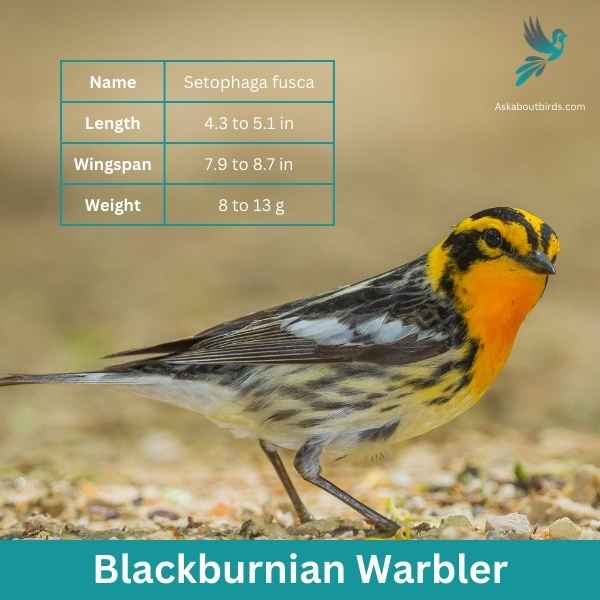

| Feature | Measurement |
|---|---|
| Scientific Name | Setophaga fusca |
| Length | 4.3 to 5.1 in |
| Wingspan | 7.9 to 8.7 in |
| Weight | 8 to 13 g |
The Blackburnian Warbler is a strikingly colored songbird that captivates observers with its vivid plumage, especially during the breeding season. Often found flitting high in the treetops of North American forests, its melodious song is as enchanting as its appearance.
Appearance: Male Blackburnian Warblers are distinguished by their fiery-orange throats, contrasting sharply with a black face, crown, and streaked back. They also have white underparts with black streaks on the sides. Females have a more muted coloration, with a yellowish or pale orange throat and less pronounced streaking.
Diet: Blackburnian Warblers primarily feed on insects and spiders. They are adept at foraging in the canopy, where they glean insects from the surface of leaves and branches or catch them mid-air in quick, agile flights.
Reproduction: Blackburnian Warblers build their nests high up in coniferous trees, often on horizontal branches. The nest is a neat cup made of twigs, grass, and moss, lined with softer materials like hair or feathers. The female lays a clutch of 4 to 5 eggs and takes the lead in incubation.
Spot-breasted Oriole
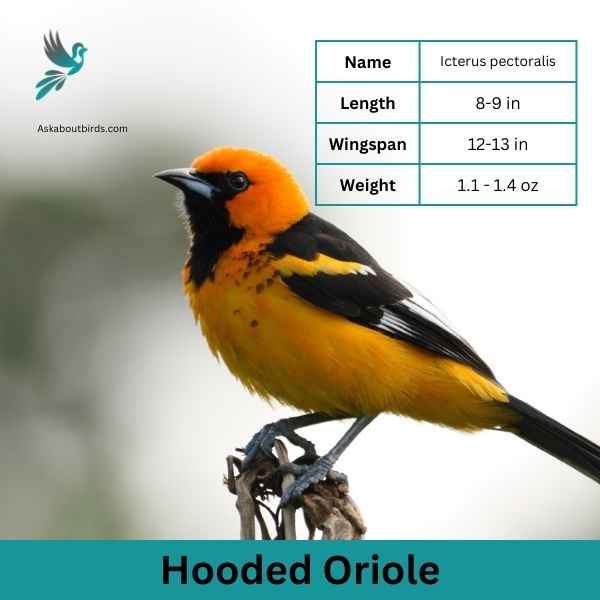
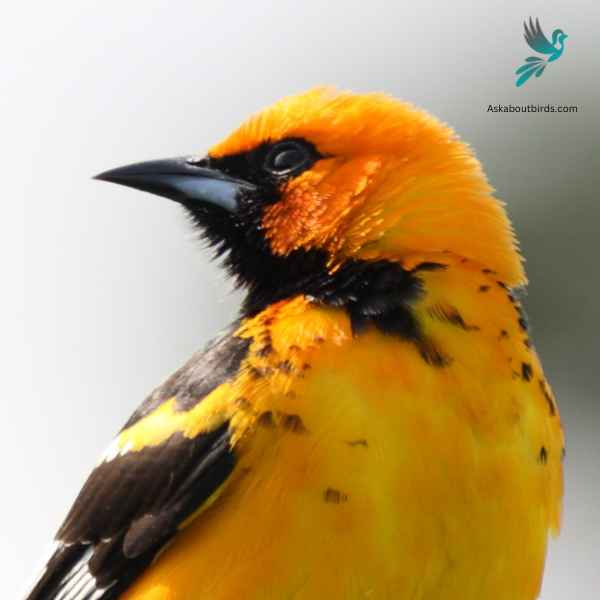
| Feature | Measurement |
|---|---|
| Scientific Name | Icterus pectoralis |
| Length | 8-9 in |
| Wingspan | 12-13 in |
| Weight | 1.1 – 1.4 oz |
The Spot-breasted Oriole is an attractive bird, native to Central America but has been introduced and established itself in certain parts of the United States, particularly in Florida.
Appearance: This oriole showcases a striking combination of colors with its bright orange body and distinctive black spots on its breast and throat. Its wings and tail are black, contrasting sharply with its vibrant body color. The beak and eyes are also black, adding to its distinctive appearance.
Diet: Spot-breasted Orioles feed primarily on a variety of insects, fruits, and berries. They are also known to consume nectar from flowering plants and can sometimes be seen at backyard fruit feeders.
Reproduction: These orioles typically build hanging basket-like nests on tree branches. Once hatched, both parents play an active role in feeding and caring for the chicks until they fledge.
Where to Spot Florida’s Orange Birds
Dotted with lush wetlands, palm-lined beaches, and dense forests, Florida offers some of the best bird-watching locales in the United States. Let’s embark on a journey across this tropical paradise to uncover the top 5 hotspots, known for the awe-inspiring display of orange birds.
- Everglades National Park: A UNESCO World Heritage Site, this sprawling wilderness is home to a wealth of bird species. Boardwalks and hiking trails give you a front-row seat to the bird-watching spectacle.
- Corkscrew Swamp Sanctuary: This Audubon Center in Naples houses the largest remaining stand of bald cypress in North America, providing a unique habitat for a range of orange birds.
- Merritt Island National Wildlife Refuge: Located near the Kennedy Space Center, this refuge boasts diverse habitats – from coastal dunes to hardwood hammocks, making it a bird-watching paradise.
- Dry Tortugas National Park: Accessible only by boat or seaplane, this remote park offers exceptional bird-watching opportunities, especially during spring migration.
- Ding Darling National Wildlife Refuge: Named after a famous cartoonist and conservationist, this refuge on Sanibel Island is famous for its spectacular bird life and is especially known for its migratory bird population.
| State’s Orange Birds | Best Spot |
|---|---|
| Georgia’s Orange Birds | Okefenokee National Wildlife Refuge, Piedmont Park, Chattahoochee River National Recreation Area |
| Alabama’s Orange Birds | Wheeler National Wildlife Refuge, Dauphin Island, Gulf State Park |
FAQs on Orange Bird Species Found in Florida
What orange bird is native to Florida?
In Southern Florida, the bird known for its bright orange patches and often seen near forest edges is the Baltimore Oriole. While they have breeding grounds in Northern Florida, these birds often migrate to South America during certain times of the year.
What bird is orange in color?
One prominent bird that displays an orange hue is the Baltimore Oriole, recognized for its bright orange patches, black and white wings, and sometimes a white head. They are frequently spotted in areas with bird feeders, especially when filled with black oil sunflower seeds.
What birds are light orange?
Few birds exhibit a light orange or rusty orange breast. Some small birds, like the Baltimore Oriole, can also have light brown to yellow-orange shades. Their presence can often be marked by their two white wing bars and their preference to eat insects near forest edges.
What are the beautiful orange birds called?
The beautiful birds with bright yellow to orange bars and often a mix of orange and black birds are generally referred to as Orioles. They stand out with their greenish-yellow hue and black and white wings, making them a visual treat especially when they visit bird feeders in search of food.





